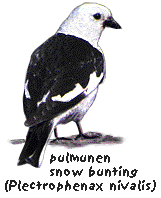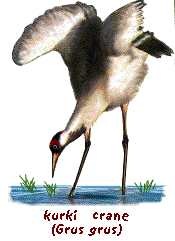
In Finland there are about 240 birds nesting and about 75% of them are migrating birds. In the north the amount of migrating birds is even greater. Most of our migrating birds fly to south for winter but for example dipper comes from north to overwinter here in Finland.
For example hazel hen, magpie, black woodpecker and siberian jay are resident birds: they spend the winter in north. Crow is one of our partial migrants. In Lapland it migrates near settlement or near the Arctic Ocean, but in the province of Oulu it doesn’t usually migrate at all. Similar to that in the north is for example great tit. Migratory birds are for example great grey owl, great-spotted woodpecker, waxwing and coal tit. If there isn’t enough food, then they migrate to find better places.
The timing of migration is few weeks ahead in the west coast area than in eastern Lapland. That’s because of the different migrate routes and also because of biotopes that are warmer. The snow cover is thinner in the west, so there are snow-free places earlier. In the coast the settlement is denser, so there are also more food. Also shallow shore waters are free of ice earlier. See for example species list about when different migratory birds arrive to Kemi- Tornio area or to Kuusamo.
 As the spring proceeds the norther the migration moves. The arrival time of early migraters is clearly longer from south to north than the time of later migraters. For example sky lark can be found from the southern coast one month earlier than from Rovaniemi, when temminck’s stint is in the north only one week later than in the south. So the migratory birds follow the proceeding of the spring and move norther when the weather and snow situations are favourable.
As the spring proceeds the norther the migration moves. The arrival time of early migraters is clearly longer from south to north than the time of later migraters. For example sky lark can be found from the southern coast one month earlier than from Rovaniemi, when temminck’s stint is in the north only one week later than in the south. So the migratory birds follow the proceeding of the spring and move norther when the weather and snow situations are favourable.
In the northern inland the first signs of spring are brought by crow and greenfinch. In the coast the first ones are herring gulls, they arrive just before snow buntings, which can arrive already in late March if the weather is favourable.
That’s when the first whooper swans arrive, too. They move quickly in to inland’s ice-free rivers. After one or two weeks arrive goldeneyes and after that mallards and goosanders. At the same time arrives first small birds like chaffinchs and starlings, in the fields you can find sky lark, curlew and lapwing and in open marshes you can see the first big migraters, bean gooses. In the coast side of the northern part of the Gulf of Bothnia first come herring gulls and great black-backed gulls and then black-headed gulls, they arrive to the big dumps.
In the late April the action begins. First ones are the mixed flocks of fieldfares and redwings, bramling, siskin, white wagtail and first cranes arrive to the marshes. From the forest you can hear the bright song of robin, buntings are jumping in the bushes also rough-legged buzzard, buzzard and kestrel can be seen and the first birds of prey appear to the sky.

 The most of the migrating birds arrive in May, which is when the insectivores come. Willow warbler, redstart, pied flycatcher and in the north thrush nightingale and bluethroat begin to migrate in the beginning of May almost at the same time with martins.
The most of the migrating birds arrive in May, which is when the insectivores come. Willow warbler, redstart, pied flycatcher and in the north thrush nightingale and bluethroat begin to migrate in the beginning of May almost at the same time with martins.
Above water you’ll see terns and osprey, in the waters most of the ducks and in the shores ringed plover, redshanks, wood sandpiper and common sandpiper. A bit later comes other shorebirds to shores and marshes, also the characteristic fell bird golden plover can be heard already before mid May.
Late migraters are spotted flycatcher, some sylvia species, like whitethroat, dunlin and other calidris -species and red-necked phalarope. They arrive at the same time with cuckoo. The last but not the least are swift and garden warbler. The first migraters of those species arrive in the early June and the migration may last over mid June.
Autumn migration is much imperceptible and it takes quite a long time. It happens mostly during night time and starts like creeping.
The first migrators leave already in the early summer, some in the late May. Male ducks leave immediately when the incubation starts. They gather in to big flocks and leave fledglings to females. Early leavers are also many shorebirds, curlew already in May and in the beginning of June follow ruff, sandpipers and their allies and lapwing. In many shorebirds it’s the female that leaves first and male takes care of the fledglings and even incubates. Of perching birds in June leave only first starlings, other species start to migrate in July. Many of those birds that leave already in June have lost their nests or are too young to nest.
Ruffs loose the courtship ‘outfit’ they have in the spring before autumn migration (see the picture). The courtship outfit has for example colourful collar valances. The reeve is smaller and the colours are modest.
The end of July is already busy time for returners. Anyhow there aren’t big flocks of migratory birds, they just disappear from the inland. They gather in to certain places to form bigger flocks. Many broods are already able to fly and they leave too. Swallows gather in to flocks, last starlings fly restlessly in big flocks and first white wagtail groups appear to the roadsides.
Most shorebirds disappear in August and perching birds seek for food everywhere in bushes and in courtyards. Big birds of prey and first cranes start their migration, although the main migration is in September. In September the migration can also be noticed the best. Thrushes and chaffinches come to courtyards and cranes, wood pigeons, pipits and buntings are found from fields. Thrushes fly after rowan tree berries to courtyards and to parks, cranes gather in to big flocks to unthreshed fields.
 In the end of September almost all migratory birds have left, only about twenty species stay until October. The species that came first in the spring, common and herring gulls, snow buntings and swans start their return now, although part of them may stay until the first frost. Part of thrushes and chaffinches may stay late too, and some might even try to pass the winter here, too. Also ducks that get their food from waters are not in a hurry to migrate, especially mallard, goldeneye and goosander.
In the end of September almost all migratory birds have left, only about twenty species stay until October. The species that came first in the spring, common and herring gulls, snow buntings and swans start their return now, although part of them may stay until the first frost. Part of thrushes and chaffinches may stay late too, and some might even try to pass the winter here, too. Also ducks that get their food from waters are not in a hurry to migrate, especially mallard, goldeneye and goosander.
The section "The migration of birds" ends here!